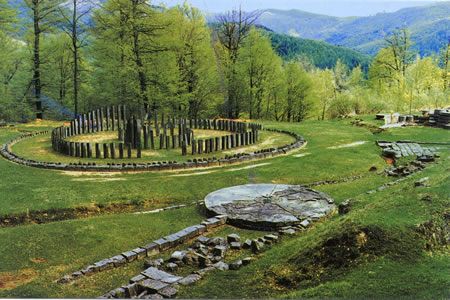
The Dacian state was formed as a result of the development of the north Thracian space. The unification of the north Thracian tribes was generated mainly by economic development.
In the space inhabited by the Dacians were recorded great progresses in the processing of iron, therefore the tools work enabling a development of agriculture.
The economic exchanges have intensified, Greek merchants arriving at the Geto-Dacian settlements bringing art objects, jewelry and taking in exchange agricultural products, honey, furs. The direct exchange of products is replaced by currency .
The unification of Geto-Dacian tribs in a state was determined by the menace represented by the Romans in the Black Sea area and Dobrogea in the century I BC.
The tribal leader of union, Burebista, began to unify the Geto-Dacian tribes in the year 82 BC. During the 60-59 BC, after the unification of the tribes of Carpathian Mountains arc, Burebista and has strengthened the position until Moravia and middle-Danube area.
The new state has been called Dacia and the area of Orastie Mountains (known as Sureanu Mountains) was the center of economic, political and spiritual Dacia, the area called Sacred Mountain or Kogaion.
The capital of Dacian state, Sarmizegetusa, represented the main political and religious center. It was structured in three parts: civil settlements, the sacral area and the fortress.
Besides the fortress located in Sarmizegetusa, the capital was defended by fortresses from surroundings: Costesti, Blidaru, Rosie Stone, Capalna, Banita, Tilisca and numerous towers.
The Fortresses were built of stone in a special technical.
The Sarmizegetusa fortress was built on Gradistea Hill. The Dwellings that belonged to the richest of people there were near the fortress. In one of the houses the archaeologists have discovered a medical kit comprising five small vessels of clay for salves, a knife and a stone from the volcanic ashes, probably for its astringent qualities. All these were in small wooden box with handlebars iron caught in two bracelets.
The sacral sanctuaries had rectangular or circular aspect and were built in the reign of Burebista and later during Decebal reign.
Dacia corresponds in large part to the current Romania.
After the death of Burebista one of the important kings was Decebal (87 - 106 en) who ensured continuity in state in Sureanu Mountains area. Under Decebal Dacians had fought against the Romans during the time of Domitian and Traian, a part of the territory of Dacia was transformed in province in the Roman Empire, the Romanian introducing their own forms of administrative organization.

































